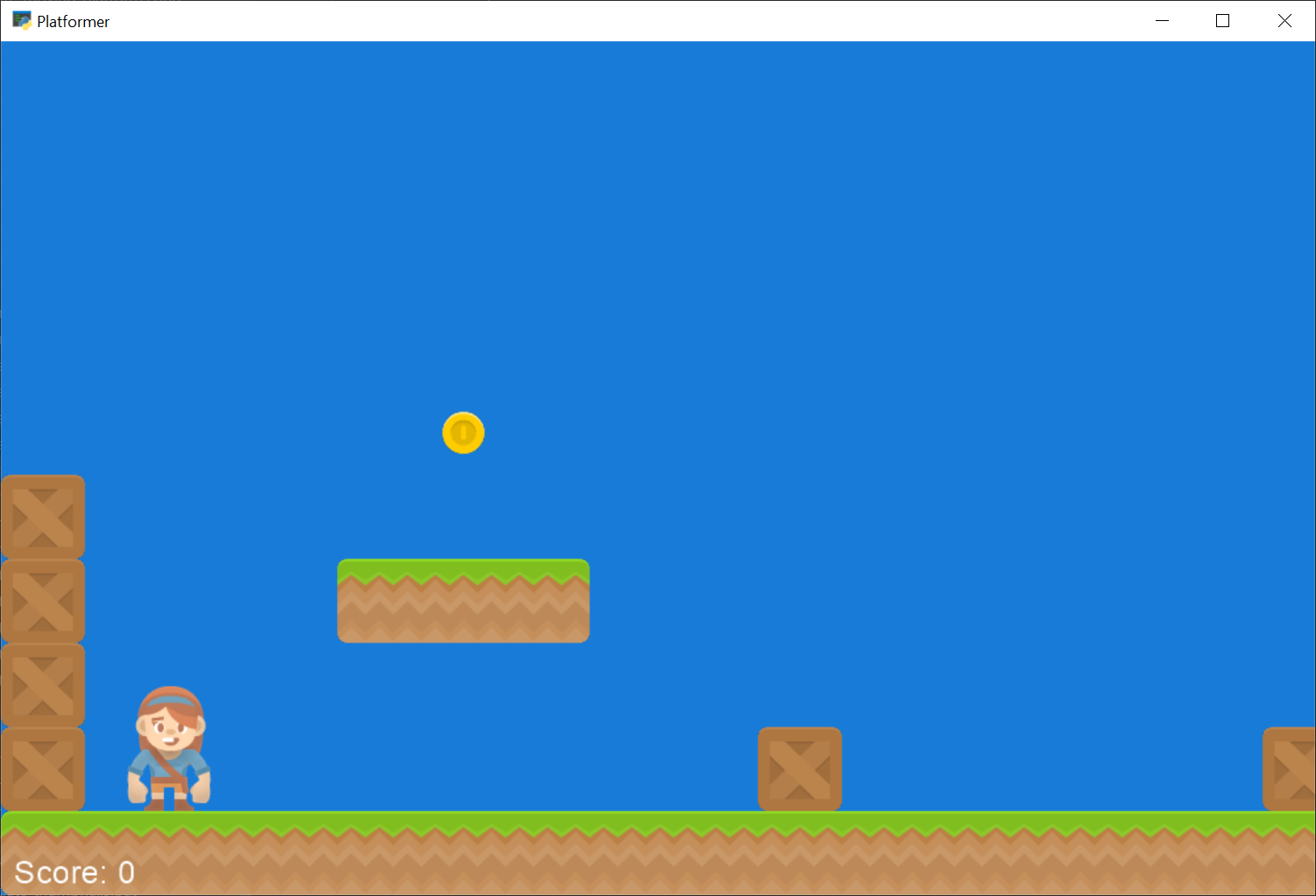平台模板#
快速开始创建您自己的平台!

关于此模板#
这是一个让你尽快开始编写侧滚平台的模板。我建议采取以下步骤:
创建一个文件夹来存放代码。将此示例复制到该文件夹,并将其命名为
main.py。确保示例代码运行良好。
将要使用的磁贴图像复制到包含代码的文件夹的子目录中。
创建一个非常简单的平铺地图使用 Tiled Map Editor 。我建议只创造一个地板,而不是其他的。有关如何创建切片地图的详细信息,请参阅 第9步-使用切片地图编辑器 。
将文件保存到与源代码相同的目录中。如果创建单独的平铺集,还要将其保存到与代码相同的目录中。
更新代码以加载您的文件而不是地图。
测试并确保它工作正常。
既然你确信一切正常,那就做你自己的平台吧!
警告
注意目录!
最常见的错误之一是将地图和切片集保存到与代码不同的目录中。或者在该文件夹中没有磁贴图像。如果所有内容都不在同一文件夹(或子文件夹)中,则很难在以后将其打包。
有关更详细的说明,请参阅教程 简单平台 。
源代码#
template_platformer.py#
1 2 3 4 5 6 7 8 9 10 11 12 13 14 15 16 17 18 19 20 21 22 23 24 25 26 27 28 29 30 31 32 33 34 35 36 37 38 39 40 41 42 43 44 45 46 47 48 49 50 51 52 53 54 55 56 57 58 59 60 61 62 63 64 65 66 67 68 69 70 71 72 73 74 75 76 77 78 79 80 81 82 83 84 85 86 87 88 89 90 91 92 93 94 95 96 97 98 99 100 101 102 103 104 105 106 107 108 109 110 111 112 113 114 115 116 117 118 119 120 121 122 123 124 125 126 127 128 129 130 131 132 133 134 135 136 137 138 139 140 141 142 143 144 145 146 147 148 149 150 151 152 153 154 155 156 157 158 159 160 161 162 163 164 165 166 167 168 169 170 171 172 173 174 175 176 177 178 179 180 181 182 183 184 185 186 187 188 189 190 191 192 193 194 195 196 197 198 199 200 201 202 203 204 205 206 207 208 209 210 211 212 213 214 215 216 217 218 | """ Platformer Template """ import arcade # --- Constants SCREEN_TITLE = "Platformer" SCREEN_WIDTH = 1000 SCREEN_HEIGHT = 650 # Constants used to scale our sprites from their original size CHARACTER_SCALING = 1 TILE_SCALING = 0.5 COIN_SCALING = 0.5 SPRITE_PIXEL_SIZE = 128 GRID_PIXEL_SIZE = SPRITE_PIXEL_SIZE * TILE_SCALING # Movement speed of player, in pixels per frame PLAYER_MOVEMENT_SPEED = 10 GRAVITY = 1 PLAYER_JUMP_SPEED = 20 class MyGame(arcade.Window): """ Main application class. """ def __init__(self): # Call the parent class and set up the window super().__init__(SCREEN_WIDTH, SCREEN_HEIGHT, SCREEN_TITLE, resizable=True) # Our TileMap Object self.tile_map = None # Our Scene Object self.scene = None # Separate variable that holds the player sprite self.player_sprite = None # Our physics engine self.physics_engine = None # A Camera that can be used for scrolling the screen self.camera_sprites = None # A non-scrolling camera that can be used to draw GUI elements self.camera_gui = None # Keep track of the score self.score = 0 # What key is pressed down? self.left_key_down = False self.right_key_down = False def setup(self): """Set up the game here. Call this function to restart the game.""" # Setup the Cameras self.camera_sprites = arcade.Camera(self.width, self.height) self.camera_gui = arcade.Camera(self.width, self.height) # Name of map file to load map_name = ":resources:tiled_maps/map.json" # Layer specific options are defined based on Layer names in a dictionary # Doing this will make the SpriteList for the platforms layer # use spatial hashing for detection. layer_options = { "Platforms": { "use_spatial_hash": True, }, } # Read in the tiled map self.tile_map = arcade.load_tilemap(map_name, TILE_SCALING, layer_options) # Initialize Scene with our TileMap, this will automatically add all layers # from the map as SpriteLists in the scene in the proper order. self.scene = arcade.Scene.from_tilemap(self.tile_map) # Set the background color if self.tile_map.background_color: arcade.set_background_color(self.tile_map.background_color) # Keep track of the score self.score = 0 # Set up the player, specifically placing it at these coordinates. src = ":resources:images/animated_characters/female_adventurer/femaleAdventurer_idle.png" self.player_sprite = arcade.Sprite(src, CHARACTER_SCALING) self.player_sprite.center_x = 128 self.player_sprite.center_y = 128 self.scene.add_sprite("Player", self.player_sprite) # --- Other stuff # Create the 'physics engine' self.physics_engine = arcade.PhysicsEnginePlatformer( self.player_sprite, gravity_constant=GRAVITY, walls=self.scene["Platforms"] ) def on_draw(self): """Render the screen.""" # Clear the screen to the background color self.clear() # Activate the game camera self.camera_sprites.use() # Draw our Scene # Note, if you a want pixelated look, add pixelated=True to the parameters self.scene.draw() # Activate the GUI camera before drawing GUI elements self.camera_gui.use() # Draw our score on the screen, scrolling it with the viewport score_text = f"Score: {self.score}" arcade.draw_text(score_text, start_x=10, start_y=10, color=arcade.csscolor.WHITE, font_size=18) def update_player_speed(self): # Calculate speed based on the keys pressed self.player_sprite.change_x = 0 if self.left_key_down and not self.right_key_down: self.player_sprite.change_x = -PLAYER_MOVEMENT_SPEED elif self.right_key_down and not self.left_key_down: self.player_sprite.change_x = PLAYER_MOVEMENT_SPEED def on_key_press(self, key, modifiers): """Called whenever a key is pressed.""" # Jump if key == arcade.key.UP or key == arcade.key.W: if self.physics_engine.can_jump(): self.player_sprite.change_y = PLAYER_JUMP_SPEED # Left elif key == arcade.key.LEFT or key == arcade.key.A: self.left_key_down = True self.update_player_speed() # Right elif key == arcade.key.RIGHT or key == arcade.key.D: self.right_key_down = True self.update_player_speed() def on_key_release(self, key, modifiers): """Called when the user releases a key.""" if key == arcade.key.LEFT or key == arcade.key.A: self.left_key_down = False self.update_player_speed() elif key == arcade.key.RIGHT or key == arcade.key.D: self.right_key_down = False self.update_player_speed() def center_camera_to_player(self): # Find where player is, then calculate lower left corner from that screen_center_x = self.player_sprite.center_x - (self.camera_sprites.viewport_width / 2) screen_center_y = self.player_sprite.center_y - (self.camera_sprites.viewport_height / 2) # Set some limits on how far we scroll if screen_center_x < 0: screen_center_x = 0 if screen_center_y < 0: screen_center_y = 0 # Here's our center, move to it player_centered = screen_center_x, screen_center_y self.camera_sprites.move_to(player_centered) def on_update(self, delta_time): """Movement and game logic""" # Move the player with the physics engine self.physics_engine.update() # See if we hit any coins coin_hit_list = arcade.check_for_collision_with_list( self.player_sprite, self.scene["Coins"] ) # Loop through each coin we hit (if any) and remove it for coin in coin_hit_list: # Remove the coin coin.remove_from_sprite_lists() # Add one to the score self.score += 1 # Position the camera self.center_camera_to_player() def on_resize(self, width, height): """ Resize window """ self.camera_sprites.resize(int(width), int(height)) self.camera_gui.resize(int(width), int(height)) def main(): """Main function""" window = MyGame() window.setup() arcade.run() if __name__ == "__main__": main() |